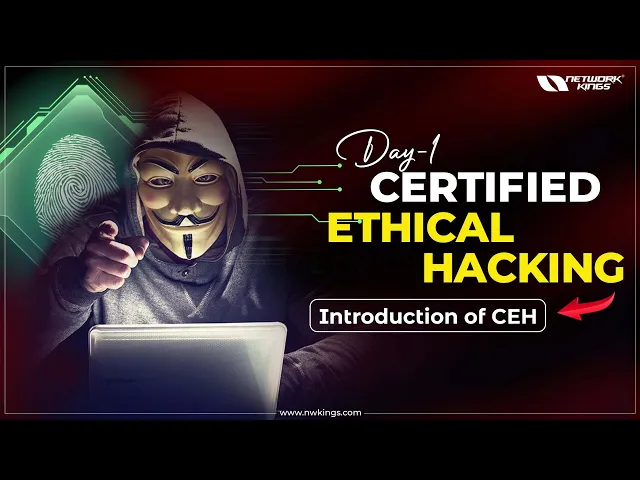
Ethical Hacking | CEH | Cybersecurity
Wednesday, May 15, 2024
Introduction
The field of cybersecurity is vast and constantly evolving with new threats and defense mechanisms emerging every day. One of the most significant aspects of cybersecurity is ethical hacking, which serves as a proactive form of securing systems and networks by identifying vulnerabilities from an attacker’s perspective. The Certified Ethical Hacker (CEH) program is designed to equip individuals with the knowledge and skills needed to protect their systems effectively. In this blog post, we dive deep into the structure, content, and significance of the CEH certification, focusing on its practical and theoretical components.
What is CEH?
Certified Ethical Hacking (CEH) is an extensive information system security auditing program that addresses the latest security threats, advanced attack vectors, and demonstrates real-time hacking techniques, methodologies, tools, and security measures employed by attackers. It’s tailored to help security professionals understand how to find and fix vulnerabilities in their systems.
Key Components of the CEH Exam
CEH offers two main types of exams:
Theoretical Exam – This is primarily MCQ based and tests a wide range of theoretical knowledge within cybersecurity.
Exam Code: CEH Version 12
Format: 120 multiple-choice questions
Duration: 4 hours
Practical Exam – Focusing more on hands-on skills, this exam is crucial for those who want to apply knowledge in practical scenarios.
Duration: 6 hours
Challenges: 20 practical challenges, with a requirement to solve 14 correctly to pass (70% success rate).
Why the Focus on Practical Skills?
The program emphasizes a practical approach, where approximately 80% to 85% of the training involves hands-on activities, and the remaining 10% to 15% covers theoretical knowledge. This methodology ensures that candidates can apply what they learn effectively, aligning theoretical insights with real-world applications.
“Understanding practical applications greatly enhances your theoretical knowledge.”
The Structure of CEH Training
The CEH curriculum includes a well-rounded set of modules, each designed to tackle key areas in cybersecurity. There are 20 modules in total, starting with an introductory module on ethical hacking and progressing through various critical aspects of cybersecurity.
Module Overviews:
Module 1: Introduction to Ethical Hacking: This module covers the basics, including different hacking methodologies, frameworks, security laws, and standards. This foundational knowledge is crucial for understanding the depth and breadth of cybersecurity.
Module 2: Footprinting and Reconnaissance: Focuses on information gathering techniques, a critical first step in ethical hacking where the hacker collects as much information about the target as possible.
Module 3 to 5: Scanning Networks, Enumeration, and Vulnerability Analysis: These modules deal with identifying live hosts, open ports, services running on ports, and detecting vulnerabilities and loopholes in the system.
Modules 6: System Hacking: Once vulnerabilities have been identified, this module explores how an attacker gains access to the system and escalates privileges.
Modules on Wireless Networks, IoT, and Cloud Security: These sections explore hacking methodologies applicable to different environments, such as wireless networks, Internet of Things (IoT), and cloud systems.
The training culminates with advanced modules including web server attacks, SQL injection techniques, and cryptography. Each module is designed to build upon the previous one, ensuring a comprehensive understanding of ethical hacking from start to finish.
Practical Labs and Environment Setup
Practical skills are sharpened through simulated environments where learners can apply hacking techniques safely and legally. Learners set up their own labs using virtual machines, where they configure attack scenarios and test various hacking tools and techniques. This hands-on experience is invaluable, ensuring that learners can handle real-world security challenges.
Information Security Fundamentals
An underlying theme in the CEH course is the emphasis on core information security principles:
Confidentiality, Integrity, and Availability (CIA): These are the fundamental pillars of information security.
Authentication and Authorization: These concepts are important in determining user permissions and access control within systems.
Non-repudiation: Ensures that both the sender and receiver in a communication cannot deny their actions.
Understanding these principles is crucial for anyone looking to make a career in cybersecurity, as it forms the basis for all security measures and policies implemented within an organization.
Conclusion
The Certified Ethical Hacker (CEH) program offers a thorough dive into the world of cybersecurity, focusing on both the theoretical and practical aspects essential for securing systems effectively. Whether you’re beginning your journey in cybersecurity or looking to bolster your existing skills, the CEH certification provides the knowledge and hands-on experience needed to face the cybersecurity challenges of today and tomorrow.
Remember, the path to becoming a proficient ethical hacker is both exciting and demanding, with a promise of a fulfilling career dedicated to safeguarding digital assets against evolving cyber threats.
Are you ready to undertake the challenge and become an ethical hacker? Join us as we explore more in this series on ethical hacking and cybersecurity—stay tuned!
The founder of Network Kings, is a renowned Network Engineer with over 12 years of experience at top IT companies like TCS, Aricent, Apple, and Juniper Networks. Starting his journey through a YouTube channel in 2013, he has inspired thousands of students worldwide to build successful careers in networking and IT. His passion for teaching and simplifying complex technologies makes him one of the most admired mentors in the industry.




